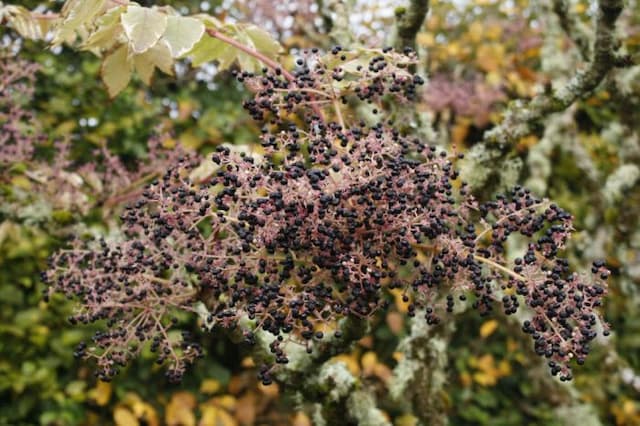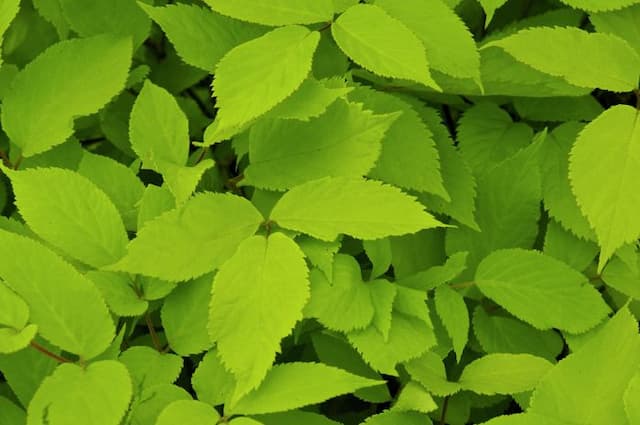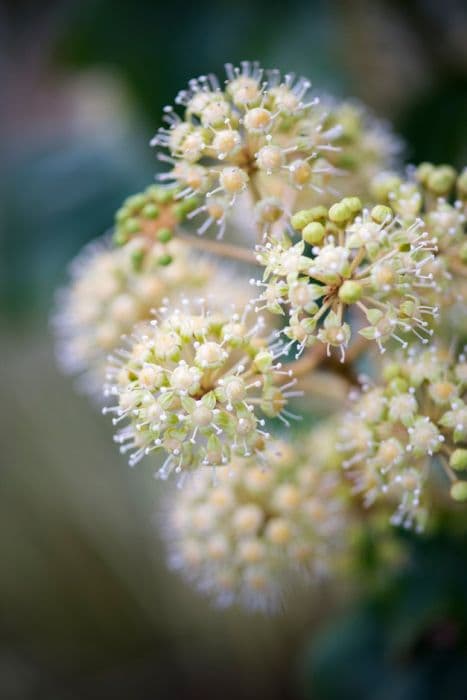Kashmir Aralia Aralia cachemirica

ABOUT
The Kashmir Aralia, as it's commonly known, has a lush and ornamental appearance. The plant features an intricate array of leaves that are particularly noteworthy for being compound, meaning that they are made up of multiple leaflets arranged on a central stem. These leaflets are typically shaped with a somewhat oval form graced with pointy tips and humble serrations along their edges, giving them a slightly feathery aspect. The large, deep green tone of the leaves can add a vivid and dense layer of foliage to any space. During its blooming period, the Kashmir Aralia produces inconspicuous, yet charming clusters of small flowers that could easily go unnoticed amongst the commanding presence of the leaves. The blossoms generally possess a subtle color that blends harmoniously with the greenery. The Kashmir Aralia also bears fruit that can catch the eye, typically developing into small, dark-colored berries that could add to the visual interest of the plant during the season when they are present. The overall impression of the Kashmir Aralia is of a plant that offers a refined and somewhat tropical aura, often preferred for its decorative leaf structure and the serene ambiance it imparts.
About this plant
 Names
NamesFamily
Araliaceae
Synonyms
Kashmir Aralia
Common names
Aralia cachemirica.
 Toxicity
ToxicityTo humans
As of my last update, there is limited specific information readily available regarding the toxicity of Aralia cachemirica, commonly known as Kashmir Aralia, to humans. General knowledge of Aralia species suggests that they may contain saponins, which can be toxic if ingested in large quantities. However, without specific studies or data on Aralia cachemirica, it is difficult to provide a definitive statement about its potential toxicity to humans or the symptoms of poisoning. If any part of the plant were to be ingested and cause toxicity, symptoms might include gastrointestinal discomfort such as nausea, vomiting, or diarrhea. In general, it is advisable to avoid ingesting plants that are not commonly recognized as safe for consumption, and to consult a medical professional or poison control center if suspected poisoning occurs.
To pets
Specific information on the toxicity of Aralia cachemirica, commonly known as Kashmir Aralia, to pets is also not broadly documented as of my last update. Similar to the situation in humans, Aralia species are sometimes considered potentially toxic to pets due to compounds such as saponins. If Kashmir Aralia were toxic to pets and ingestion occurred, symptoms could potentially include vomiting, diarrhea, and other gastrointestinal disturbances. As there is a lack of specific data regarding the toxicity of Aralia cachemirica to pets, pet owners should exercise caution and prevent pets from ingesting plants that are not known to be safe. If a pet is suspected of having ingested part of the plant and exhibits signs of distress, a veterinarian should be consulted immediately.
 Characteristics
CharacteristicsLife cycle
Perennials
Foliage type
Deciduous
Color of leaves
Green
Flower color
White
Height
6 feet (1.83 meters)
Spread
6 feet (1.83 meters)
Plant type
Shrub
Hardiness zones
7
Native area
Kashmir
Benefits
 General Benefits
General Benefits- Ornamental value: Aralia cachemirica, commonly known as Kashmir Aralia, is often used for landscaping and as a decorative plant because of its unique foliage and structural appearance.
- Habitat for wildlife: It can provide shelter and food for a variety of insects and birds, thereby supporting local biodiversity.
- Shade provider: Larger specimens can offer a reasonable amount of shade in gardens and parks, making them a practical addition in landscape design.
- Windbreak: The plant can act as a windbreak or privacy screen when planted in rows and can help to protect more sensitive areas of the garden.
- Soil stability: Its root system can help prevent soil erosion, particularly in sloped areas of a garden or in regions with loose soil.
- Cultural significance: In some cultures, Aralia plants may have traditional significance and are used in rituals or as symbols of protection.
 Medical Properties
Medical Properties- Anti-inflammatory: It may possess properties that help reduce inflammation.
- Analgesic: Some compounds in the plant might be used for pain relief.
- Antioxidant: Aralia cachemirica could contain antioxidants, which help in preventing oxidative stress and damage.
- Immune modulation: The plant may have components that could potentially modulate the immune system.
- Adaptogenic: There might be adaptogenic properties, contributing to the body's ability to resist stressors.
 Air-purifying Qualities
Air-purifying QualitiesThis plant is not specifically known for air purifying qualities.
 Other Uses
Other Uses- Aralia cachemirica, commonly known as Kashmir Aralia, is used in landscaping for its ornamental foliage and structure, adding a touch of exotic elegance to gardens.
- The plant can serve as a natural privacy screen when cultivated in dense clusters, due to its height and leaf density.
- Kashmir Aralia is used in bonsai culture due to its interesting bark texture and the ability to prune into various shapes.
- The large leaves of Kashmir Aralia can be used as a natural mulch, as they break down and enrich the soil with organic matter.
- In some cultures, the wood of Kashmir Aralia is utilized in making small handcrafted items or as part of decorative wooden arrangements.
- The plant is occasionally used in floral arrangements, particularly in large displays where its leaves add volume and a tropical touch.
- Leaf extracts from Kashmir Aralia might find use in natural dyes or inks, although this is not a common application.
- The plant's resilience to certain environmental conditions can make it a useful species for reforestation or ecological restoration projects.
- Kashmir Aralia, due to its stature and leaf structure, can provide shelter for small wildlife within a garden ecosystem.
- The unique texture of Kashmir Aralia leaves may serve as an inspiration for artistic designs, patterns in textile, or wallpaper prints.
Interesting Facts
 Feng Shui
Feng ShuiThe plant Aralia is not used in Feng Shui practice.
 Zodiac Sign Compitability
Zodiac Sign CompitabilityThe plant Aralia is not used in astrology practice.
 Plant Symbolism
Plant Symbolism- Resilience: Aralia cachemirica, commonly known as Kashmir Aralia, often symbolizes resilience due to its ability to thrive in rocky terrains and withstand difficult growing conditions.
- Protection: With its robust form, Kashmir Aralia is sometimes associated with protection, as it can create a natural shield in the landscapes where it grows.
- Longevity: Due to its perennial nature, Kashmir Aralia may symbolize long life and endurance, representing the plant's persistence through various seasons.
 Water
WaterKashmir Aralia should be watered when the top inch of soil feels dry to the touch, which typically equates to once a week, but this may change with the seasons as indoor heating can dry out the air significantly. Generally, this means providing about half a gallon of water for an average-sized indoor plant, ensuring thorough hydration but without waterlogging the soil. During the winter, reduce watering frequency to match the slower growth rate and lower evaporation rates. Overwatering is a common issue, so it is crucial to let the soil dry out slightly between watering sessions.
 Light
LightKashmir Aralia prefers bright, indirect light like that found near an east or west-facing window. Direct sunlight can scorch its leaves, so it's best to provide filtered or dappled light. If grown indoors, a spot that receives several hours of indirect sunlight while avoiding the harsh midday rays is ideal for this plant.
 Temperature
TemperatureThe ideal temperature range for Kashmir Aralia is between 60 and 85 degrees Fahrenheit. It can survive minimum temperatures down to about 50 degrees Fahrenheit for short periods, but prolonged exposure to cold can damage the plant. It should not be exposed to temperatures below 50 degrees Fahrenheit or above 85 degrees Fahrenheit to ensure healthy growth.
 Pruning
PruningPruning Kashmir Aralia is essential for maintaining its shape and encouraging fuller growth; this can be done once or twice a year, ideally during spring or early summer. Cut back any leggy growth, dead branches or leaves, and any other part of the plant that may be overgrown or unhealthy. The best time for pruning is before a new growth cycle begins so that the plant can dedicate energy to producing new, healthy foliage.
 Cleaning
CleaningAs needed
 Soil
SoilKashmir aralia prefers a well-draining potting mix with peat, pine bark, and perlite in equal parts, maintaining a soil pH around 6.0 to 6.5.
 Repotting
RepottingKashmir aralia should generally be repotted every two to three years or when it visibly outgrows its pot.
 Humidity & Misting
Humidity & MistingKashmir aralia thrives in moderate to high humidity levels, ideally between 60% to 80%.
 Suitable locations
Suitable locationsIndoor
Place near a window, avoiding direct sun, in a humid spot.
Outdoor
Plant in partial shade with shelter from strong winds.
Hardiness zone
7-9 USDA
 Life cycle
Life cycleAralia cachemirica, commonly referred to as Kashmir Aralia, begins its life cycle with seed germination, which occurs in a moist, shaded soil environment. Following germination, the seedling emerges and establishes a root system while developing primary leaves. As it transitions to the juvenile phase, the seedling grows into a young plant with a more robust root system, larger leaves, and begins to form a woody stem characteristic of this species. Reaching maturity, Kashmir Aralia produces clusters of small white flowers during its flowering stage, usually in the summer, which are pollinated by insects, leading to the development of berries. The berries then mature, turning black when ready, and contain seeds that, once dispersed, can give rise to new plants, completing the cycle. Finally, Kashmir Aralia may enter a senescence phase where growth slows, and the plant begins to deteriorate with age.
 Propogation
PropogationPropogation time
Spring-summer
Propogation: Aralia cachemirica, commonly known as Kashmir Aralia, is often propagated by seed. The most popular method of propagation for this plant is by sowing seeds. For optimal germination, the best time to propagate Kashmir Aralia is in spring after the last frost when the soil temperature has begun to warm up. The seeds should be sown in well-draining soil at a depth of approximately 1/4 inch (about 6 millimeters). It's important to keep the soil consistently moist but not waterlogged to encourage germination. The germination can be somewhat slow and uneven, so patience is necessary. Once the seedlings have developed true leaves and are of sufficient size, they can be carefully transplanted to individual pots or to their final location in the garden.









